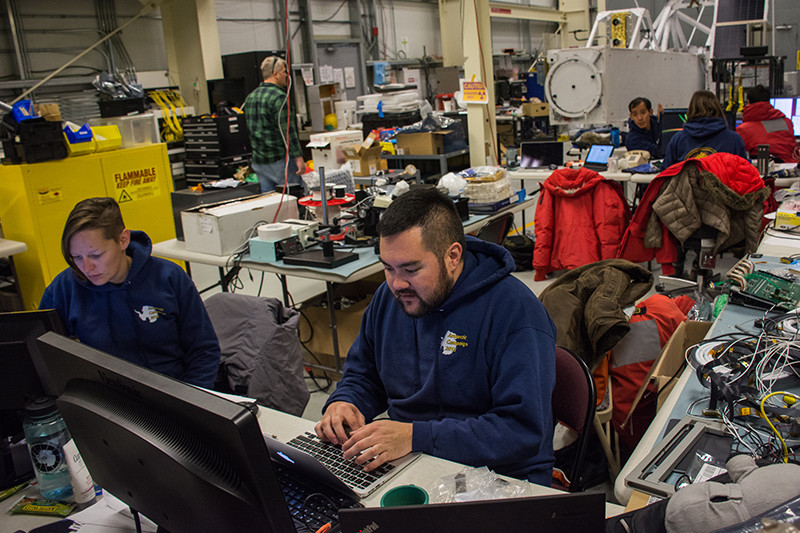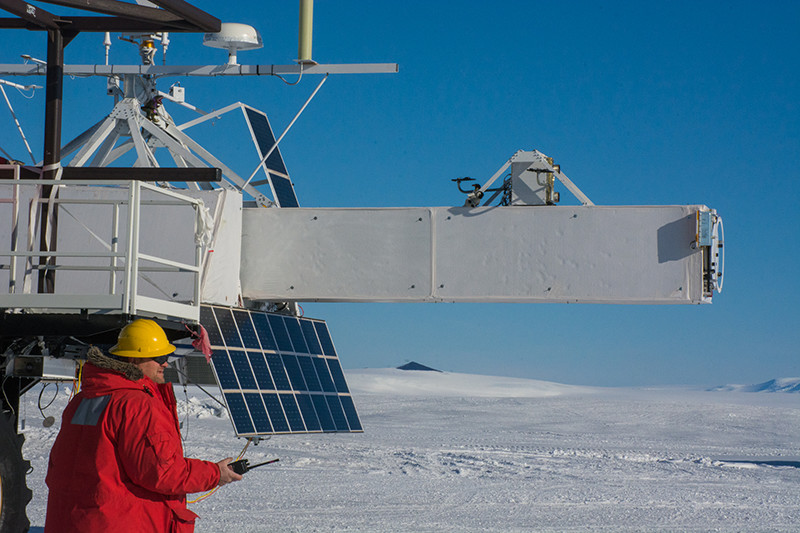
Photo Credit: Mike Lucibella
|
Hazel Bain (left) and Brent Mochizuki work on their computers in GRIPS’ small mission control, with the telescope stored in the hanger bay behind them.
|
Signatures from the Sun
By Michael Lucibella, Antarctic Sun Editor
Page 2/4 - Posted October 5, 2016
After GRIPS reached its cruising height of roughly 130,000 feet, it settled into the circumpolar current, the circular river of air over Antarctica that will take it in a grand loop around the continent. The helium balloon had expanded to the size of a football field in the thin atmosphere. After some preliminary checks and diagnostics, the team trained the telescope’s detectors at the sun and waited for the sun to erupt.

Photo Credit: Mike Lucibella
With the hanger bay doors open, workers use a crane to bring the GRIPS telescope outside for a launch attempt.

Photo Credit: Mike Lucibella
Researcher Albert Shih (left) works on the wiring of one of GRIPS’ solar panels with the help of Niharika Godbole.

Photo Credit: Mike Lucibella
Principal investigator Pascal Saint-Hilaire look out at the launch field as GRIPS hangs behind him.
Though the team is studying accelerated particles, the detectors on GRIPS aren’t tuned to detect them directly as charged particles are a poor tool for astronomical observation. Magnetic fields akin to the ones that first accelerated the sun’s ions and electrons can also deflect them. After traveling through the sun’s powerful magnetic field, it’s impossible to know just based on their direction where they’re coming from.
Instead, the detectors on the instrument are designed to look for the gamma rays and X-rays the particles emit when they interact with the sun’s atmosphere and magnetic field. This electromagnetic radiation can’t be deflected by magnetic fields so it helpfully points directly back to their source.
Trying to catch the emissions coming specifically from accelerated ions is tricky because radiation from electrons tends to swamp the signal in most frequencies.
“In gamma rays, you may be able to see signatures of ions,” Saint-Hilaire said. “Typically when you observe plasma at almost any wavelength, you always observe what the electrons are doing. But that’s only half the story.”
Past observations of where these ions and electrons originate from within the flare left researchers with a bit of an enigma. The energetic processes that accelerate ions should be the same that accelerate electrons, but when scientists traced satellite observations of the different particles back to the source, the two didn’t line up.
“The electrons and ions were actually ending up in different locations which pointed to some mystery that we still haven’t resolved about where are they getting accelerated, how are they getting to where we see them and what is going on,” Shih said.
Scientists have been observing solar flares for ages, but there are still many unknowns about the forces that power them.
“There are a lot of questions about those magnetic fields; how do you keep twisting up that magnetic field to build up the energy without letting any of the energy out and how does that energy all come out all at once,” Shih said.
He added also that the processes that actually accelerate these electrons and ions is surprisingly efficient, more so than scientists have been able to reproduce in laboratories. “You’re able to accelerate particles to huge energies, very powerful energies, and very efficiently, so there’s a huge mystery attached to that.”
Previous
1
2
3
4
Next








